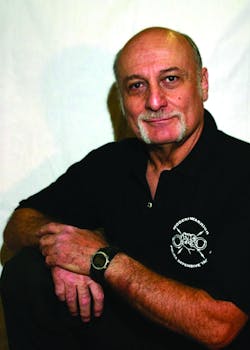Over the past 20 plus years, baton use by law enforcement officers has taken a back seat to other less-lethal tools, such as use of deterrent sprays and electronic control devices.
This decline in baton popularity is the result of the assumption that these other low and intermediate use of force options would generate less controversy and subsequently, less litigation than baton use did. This is no longer the case, despite the fact that the Rodney King incident and other similar use of force scenarios captured on video still continue to haunt the law enforcement community. Of course, the ever expanding use of inexpensive and easy to carry video cameras, including today's cell phones and dashboard cameras only perpetuates the stigma and negative perception of batons being used as tools for punishment, rather than self defense or subject control in the minds of the general population.
While there have been significant advancements in baton technology, baton training has remained primarily the same, even with the lighter and more versatile expandable batons widely available today.
Unfortunately, even with lighter batons, most baton training is still based on the belief that officers will instinctively use their baton in a club like manner and therefore the misconception continues that baton training should be based upon club like swings, with the only difference being that the lighter batons are swung more often in a shorter period of time.
More martial arts oriented instructors lean heavily on kali or escrima type swings that were very effective for martial artists who lived hundreds of years ago and certainly not subject to the use of force restrictions placed on modern day LEOs.
Rather than reduce the "image" of brutality, this unfortunately magnifies that image, especially when excessively replayed on TV and the internet. Imagine the Rodney King images with the amount of baton swings being multiplied by three times in those same seconds of edited video.
Most images we see of "perceived" brutality are actually the result of officers trying to make an ineffective technique work by simply repeating the technique over and over again! It is easy to imagine how this can be unfairly perceived by the untrained eye or those with a bias toward police as being acts of brutality.
In answer to this dilemma, a well-researched, litigation-resistant baton training system referred to as the High Efficiency, Low Profile (H.E.L.P.) Expandable Baton System has been developed.
The H.E.L.P. system is based on the concept that "defensive looking" strikes can be more effective than "offensive looking" strikes if the impact generated is based more on velocity than a combination of mass and leverage. At the same time, strikes which are defensive in both appearance and fact minimize the perception that the officer is aiming to punish the offender.
Mass is most commonly related to the weight of the baton, the strength and size of the officer, plus the rotation of the shoulders and hips. Leverage is often dependent on the stance and stability of the officer swinging the baton. Velocity and more specifically, escape velocity can be generated and enhanced though a process called "springloading."
Springloading is a concept that was developed in Greece and China in the 4th century with a catapult type weapon called a "traction trebuchet." The principle is still employed today with crossbows, slingshots and even in drag racing when the driver holds down the brake pedal as the accelerator is pressed while waiting for the starting light. By holding back energy before it is released, the escape velocity increases dramatically and impact is thereby increased at shorter distances.
Compare a train to a dragster: although a train will eventually reach a much higher velocity than a dragster, it would never win in a quarter mile race.
A baton can be springloaded by simply tucking it under the arm or by holding it back with the free hand, forearm or behind the leg and putting slight forward pressure on the baton before releasing it to block or strike. This concept naturally works much better with lighter batons, such as an expandable baton, than it would with a heavier baton such as Cocobolo.
The advantage of springloading is that the baton achieves a higher degree of impact in a shorter distance and can be launched in any direction without any wind up or telegraphing motions preceding the actual block, redirection or strike. Also, because springloading is not dependent on a wide stance or hip and shoulder rotation, the officer can theoretically block, kick and use his or her baton in a single motion and in opposite directions, with sudden and unexpected impact at shorter distances (see figures 1 and 2).
Stance, in addition to hip and shoulder rotation, are not major factors in springloading, so an expandable baton can also be effectively employed in ground fighting situations against one or more opponents along with the free hand, legs and other natural weapons (see figures 3 and 4). This ability will encourage officers to have their expandable in their hand, rather than discarding it when they fall to ground, in favor of employing empty handed techniques or taking the time to draw their firearm when deadly force may not be appropriate i.e., due to insufficient information or sensitive environments such as schoolyards, hospitals, etc.
Having the baton accessible makes the officer less susceptible to being disarmed during the upholstering transition. It is because of this increased diversity created through the process of springloading that the developers of the H.E.L.P. system have also added effective grappling tactics into the system (see figures 5 through 8).
As with most new systems, especially those that stray from traditional tactics, this system will likely go through a period of skepticism and controversy within the training community. The author (who is no stranger to controversy) believes that with time and the development of high quality and well trained Master Instructors throughout the US and Canada (where expandable batons are widely in use) that Law Enforcement Trainers and Administrators will see the advantage of having a non product specific, highly effective, yet litigation-resistant expandable baton system.
Once the paradigm shift is complete, the H.E.L.P. System will allow officers, Administrators and the general public to see batons in a whole new light. It's time for the expandable baton to climb out of the back seat and into the front where it belongs.
Phil Messina is a highly decorated NYPD Sergeant (Ret.), who has been teaching defensive tactics for over 30 years, has martial arts background of over 50 years and is the developer of key training concepts which include Goal Oriented Training, Environmental Stress Inoculation, Physio-Kinetics, Timeframing and Vortexing. Mr. Messina is the Founder and President of Modern Warrior Defensive Tactics Institute and a co-developer of the H.E.L.P. Expandable Baton System. He is also the author of Warrior 101: A Handbook for the Modern Warrior. He welcomes your comments at [email protected].
About the Author

Phil Messina
Phil Messina, author of “Warrior 101: A Handbook for the Modern Warrior,” is a highly decorated NYPD sergeant (Ret.), who has been teaching defensive tactics for over 30 years, has martial arts background of more than 50 years and is the developer of key training concepts that include goal oriented training, environmental stress inoculation, physio-kinetics, timeframing and vortexing. He is the founder and president of Modern Warrior Defensive Tactics Institute and a co-developer of the H.E.L.P. Expandable Baton System. He welcomes your comments at [email protected].
